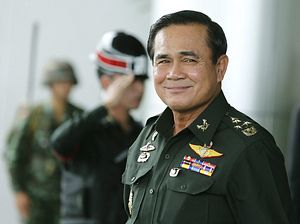Who is behind the anonymous arson and bombing attacks that fatally targeted cities and resort towns in southern Thailand over a symbolic royal holiday? While ruling junta officials have insinuated the August 11-12 attacks were staged by political groups peeved by this month’s passage of a new constitution that will more firmly entrench military rule, analysts and diplomats believe insurgents active in the country’s three southernmost Muslim majority provinces are more likely to blame.
The surprise attacks stretched across seven southern Thai provinces, causing at least four deaths, 35 injuries and a large degree of fear and loathing across the economically important tourism industry. The low-grade bombs and incendiary devices targeted Hua Hin and Phuket, beach destinations popular with both local and foreign tourists, as well as other southern provincial areas less clearly related to tourism. As is customary with insurgent attacks in their normal area of operations, no group took responsibility for the death and destruction. The coup-ousted Peua Thai political party and its affiliates openly denied any involvement.
If Barisan Revolusi Nasional-Coordinate (BRN-C) or one of its controlled insurgent offshoots is responsible, as many analysts suspect, it would mark a significant escalation in the Muslim group’s 12-year struggle for cultural and religious rights vis-a-vis the Thai state. Until now, BRN-C attacks have been almost exclusively confined to their remote home geography, namely the southernmost provinces of Narathiwat, Pattani and Yala, with less frequent assaults on adjacent Songkhla province, and have mainly avoided Western targets that could internationalize their local complaints and grievances.
Analysts and diplomats note that while BRN-C interlocutors were quick to distance themselves from last year’s Erawan shrine bombing in Bangkok – the country’s most deadly ever terror attack since blamed on ethnic Uyghurs from China – the same contacts were either unavailable or evasive about BRN-C’s role after the recent attacks. The same sources believe the attacks’ timing, coincident with Queen Sirikit’s national birthday celebrations, was highly symbolic in light of her high profile royal programs in the restive region and the fact that most junta leaders, including Prime Minister Gen. Prayut Chan-o-cha and Defense Minister Gen. Prawit Wongsuwan, hail from her elite military guard.
The attacks, including the use of staggered bombs designed to target people responding to an initial smaller blast, were consistent with known insurgent tactics in the deep South. Many of the crude devices recovered at the attack scenes, including ignition devices that used hard-to-trace Malaysian rather than more tightly controlled Thai mobile SIM cards, were similar to those used in past BRN-C attacks. BRN-C also frequently stages well-coordinated multiple assaults across wide areas to make pointed political statements, including in fiery response to reports of official abuses against its members and sympathizers.
It would not be the first time BRN-C has targeted tourist sites: a 2014 car bomb on Koh Samui, a resort island, and a 2013 foiled car bomb on Phuket, another holiday island, have both been linked to the umbrella insurgent group. Analysts and diplomats who track the shadowy conflict contend those plots were likely driven by a younger, angrier generation of fighters bent on extending the conflict up the country’s southern coast to areas popular with Western tourists to pressure the military into accepting their autonomy demands. The fact that the group’s clandestine fighters were likely operating in unfamiliar southern terrain may also explain why several of the attacks appeared to be poorly executed.
Some analysts believe the holiday attacks may have been motivated by the combination of a faltering, if not collapsed, peace process and passage of a new charter that ensures an overarching political role for the military even after new general elections are held in 2017. BRN-C launched a wildfire bombing campaign ahead of the August 7 constitutional referendum, which was passed overwhelmingly in the wider southern region but strongly rejected in the three southernmost provinces. The junta is known to have stoked local resentment and insurgent fires through heavy-handed security measures imposed after the May 2014 coup.
Analysts are now weighing whether the coordinated attacks should be viewed as a one-off warning or first salvo in a sustained campaign targeting the economically crucial tourism industry. One diplomat investigating the on-the-ground specifics of the attacks argues that only one of the multiple low-grade bomb blasts, the follow-up attack in Hua Hin, was staged to directly target tourists. An investment analyst with a U.S. fund, meanwhile, notes that the international headline-making attacks will dent foreign confidence as high-spending European travelers make their Christmas travel plans. Tourism has been one of the country’s few economic bright spots, even under military rule.
Before the attacks, Prayut and other junta officials had portrayed the August 7 referendum as a de facto vote for military-imposed stability after years of chaotic political party rule. It is thus not surprising that junta officials have bid to pin blame for the blasts on the coup-ousted Peua Thai, despite the party’s and its aligned ‘Red Shirt’ pressure group’s acceptance of the vote’s result and a lack so far of any credible evidence to link it to the attacks. Self-exiled ex-premier and de facto Peua Thai leader Thaksin Shinawatra, meanwhile, has threatened to sue for defamation anyone who accuses him of masterminding the anonymous assaults.
If Red Shirt militants aimed to stoke post-referendum violence, thereby poking holes in the military’s stability narrative and advancing the notion of a rural uprising against military rule, they would no doubt be more apt to launch shadowy attacks where they have proven organizational capacity in their northeastern stronghold, which voted only narrowly against the military’s charter. While Prayut may leverage the violence to further fracture and harass his political opponents, the royal holiday attacks blatantly show that his strongman rule has been less effective at addressing clear and present threats to national security.

































